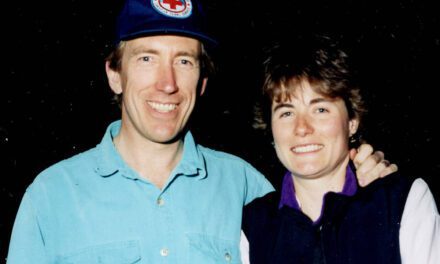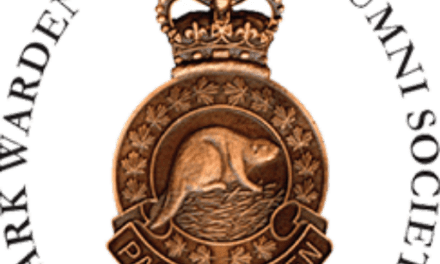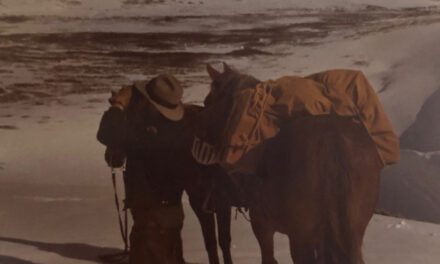(34:14) Ann – They had the big wood bison. They are much taller, especially on the hump than the plains bison. It was the wood bison that they were working with that day, the bulls. What they wanted to do was measure them in the chute that they had to see how much bigger they would have to make a chute to accommodate the wood bison. I think that they had four or five bulls to run through the chute. Bill Walburger was helping Fred…what they would do was they would measure them when they were in the chute. Bill was up on top of the chute because he would be doing the measuring and Fred was on the ground. He would open the gate and step around behind it and pull it in front of him, so that he would be behind it.
(35:46) Peggy – They had a gate made special for the chute, so it was that gate.
(35:51) Connie – It didn’t open all the way. It only opened at an angle.
(35:59) Ann – Anyway, this one particular large wood bison bull seemed to be on the fight for some reason or another…I guess Fred decided that they should get him out of there because he didn’t like the confinement while he was being measured. So Fred opened the gate, swung it back and stepped behind it so that he was leaning back up against the chute with the gate in front of him. Usually when they let the bulls out, they were just going straight out. Well this bull, he had a mad on I guess and Fred stood behind the gate and the old bull came right around the gate and just jabbed him in the chest! Bill Walburger he backed the truck up to the gate and then I guess the bull took off. He backed the truck up and Fred jumped over the fence to the gate…
(37:24) Peggy – Actually what happened was the bull was having a hard time because he couldn’t seem to put a horn through him so he rattled up and down his legs and he tried to square off with him. He couldn’t figure out why he wasn’t getting anything. So he backed up and he took a real good look. He turned his head, like “This time I am going to stick you.” My dad saw that so when the bull came, he came with that one horn and he put it right under the rib cage and he put it right through him. It just scored the inside of his ribs and it came within an inch of his heart. My dad had seen the bulls do that to the calves. You know how they stuck the horn up through a calf’s belly to throw it over their back. So he knew as soon as the bull nailed him, he that he was going over this bull’s back. He hung on to the head hair. He hung on to that long hair and he knew he was going to try to throw him, so when the bull threw him he could kind of go with him. Then he woke up on the ground.
(38:28) Connie – Yeah, it knocked the wind out of him.
(38:29) Peggy – He was laying in the snow looking up and he could see the bulls butt. So he knew the bull hadn’t turned around yet. He jumped up and then he saw his hat on the ground, his fur hat. He went and picked that up, just a reflex! And then he thought, “Why am I picking my hat up?” He ran over to the buffalo fence, you know with the wire squares. He went over to it and he climbed up. Then all the staples came out and he is hanging backwards on this fence and this bull is just ripping and tearing at his legs. Finally he hit him on the butt and threw him right over the fence. So the bull is on one side and he is on the other and Bill backed the truck up and he crawled into the back of the truck. Bill was going so fast going out of there and this bull was just on a dead run after him! He was chasing the truck.
(39:26) Connie – My dad is in the back of the truck bouncing!
(39:33) Ann – So Bill got on the radio and he said…”We’ve had an accident here, a bull hit Fred Dixon in the chest or something like that.” I was at home and I heard it come over the radio. And it was on Valentine’s Day. That is why I put a Valentine on the horn of the buffalo on the quilt.
(40:04) Connie – Then when they got him to the hospital and they asked what was wrong and he said that he got gored by a buffalo, they laughed at him.
(40:10) Peggy – They thought that he was crazy. Then when he was in the hospital after they did the exploratory and he was recovering, every nurse in the Fort Saskatchewan hospital came to look at him. They wanted to see this guy who was gored by a buffalo! Like he would look any different than anybody else! Nothing like that had ever happened at Elk Island before!
(40:38) Connie – That is a typical example of reading an animal because he knew to hang on and go with it. He knew exactly what the bull was going to do.
(40:48) Peggy – Otherwise he would have just ripped him open.
(40:50) Rod – Yeah, most of us wouldn’t have even thought that way and would have perished right there.
(40:55) Connie – You probably wouldn’t have stopped for your hat either!
(40:57) Peggy – Then after he got out of the hospital, he was able to kind of go and feed his horses and stuff. He just had to do that! Then after he was well enough he got a pulley system worked up so that he could put his saddle on the pulley and then he threw it up over the beam in the barn and then he would pull this saddle up because he couldn’t lift his saddle yet. Then he would back Old Billy up underneath it eh. Then he would saddle his horse and go for a ride.
(41:30) Sharon – How long was he in the hospital?
(41:35) Ann – In the hospital it was ten days.
(41:39) Connie – He wasn’t impressed!
(41:46) Rod – So Fred did retire at Elk Island. Do you remember what year that was?
(41:54) Ann – It was 1980, wasn’t it? Yes, because we came down here (to Pincher Creek) in 1981.
(42:06) Rod – I would like to thank everyone here. Is there anything else that you care to share with us? As we’ve said before we could probably talk for days on end here about your career and your experiences in national parks! I want to thank you on behalf of the warden alumni for doing this and providing lots of people with some real knowledge of the warden service as it used to be. It is something that is of great interest and value to all Canadians hopefully. These kinds of stories are certainly worth preserving…Thank you again on behalf of the warden alumni.
(42:49) Ann – You are welcome.
(42:52) Peggy – I would like to say thanks to you Rod for doing this because I know that you were a favorite (of Fred’s).
(43:02) Rod – Well, I know that too actually because I got some pretty special treatment when I was in Elk Island there! Ever since we met, it has been a great friendship and there are a lot of great memories.
(43:21) Ann – Were you a warden one in Elk Island?
(43:22) Rod – I was a seasonal warden in Waterton before I went to Elk Island. I went to Elk Island in 1975/76. I remember, I was only there two years and I kind of regret now in a way that I put in for a move because when I went to Elk Island I thought, “Oh gee, I wanted to stay in the mountains.” I guess I have to credit Max Winkler for convincing me that there was a good reason to send me somewhere other than the mountains to get a different experience. Especially an experience with animals and whatnot, which I was fortunate enough to do. That was one thing that I really liked about Elk Island and Fred is that we used horses year round, which for me was quite different. And we used them with animals when we trapped elk. I remember trying to trap moose. That was an exciting experience which I will tell on my oral history someday because I will never forget that! Going down an alley way with three young bull moose with redness in their eyes when they turned and decided that we were out of there. I remember Fred saying, “Get the hell out of there!” It was really scary stuff! He was a terrific person in terms of his knowledge of animals…
Fred Dixon passed away on March 1st, 1993. Ann Dixon, age 94, now lives in Milk River, close to her daughter Peggy.



